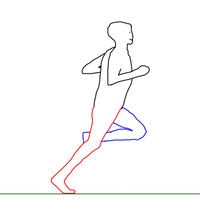Biomechanics of Running

An animation of running, taken from Fellrnr's webpage on running form.
The biomechanics of running [1] is about how we can think of a person running as an engineering system. For example, it is a widely held belief that the optimum for running (as opposed to jogging or sprinting) is 180 steps per minute (spm), independent of the speed of the runner! This is often based on pseudo-science, with very small studies (e.g. [2] considered 11 participants), or by analyzing elite runners during races, which may not be applicable to the casual runner. A useful overview of this is given by Fellrnr's webpage on cadence, but don't believe everything you read on that page either. As a second example, despite years of marketing by running shoe companies, it was only in 2019 that the first running shoe was developed that was demonstrated to reduce running injuries (by a 3rd party scientific study) [3].
Ideally, we would have a model for how running works. We would plug in a persons parameters (weight, leg length, running speed, etc), and then optimize for cadence that gives the least wasted energy. A model was given in [4], which seemed to predict well the optimal cadence for each of the runners in a small study [2]. However, that model modelled a person running as an undamped pendulum, which is clearly far from the truth!
This theoretical project, which is rather wide open and could be taken in a number of different directions depending on interest, would look at models of the biomechanics of running. For example, it could look at mechanical models of running and how these can be used to predict optimal running speed, cadence, etc. Or, it could look at running shoe design and injury prevention [3].
There are no formal pre-requisites for this project, although an interest in running, an interest in mathematical and mechanical modelling, and an ability to simulate simple models on a computer (for example using Matlab) might be helpful.
References:
- [1] Novacheck (1998) "The Biomechanics of Running", Gait & Posture 7, doi:10.1016/S0966-6362(97)00038-6.
- [2] Hamill, Derrick & Holt (1995) "Shock attenuation and stride frequency during running" Human Movement Science 14, doi:10.1016/0167-9457(95)00004-C.
- [3] Nike Project Run Fearless.
- [4] Holt, Hamill & Andres (1990) "The force-driven harmonic oscillator as a model for human locomotion" Human Movement Science 9, doi:10.1016/0167-9457(90)90035-C.
